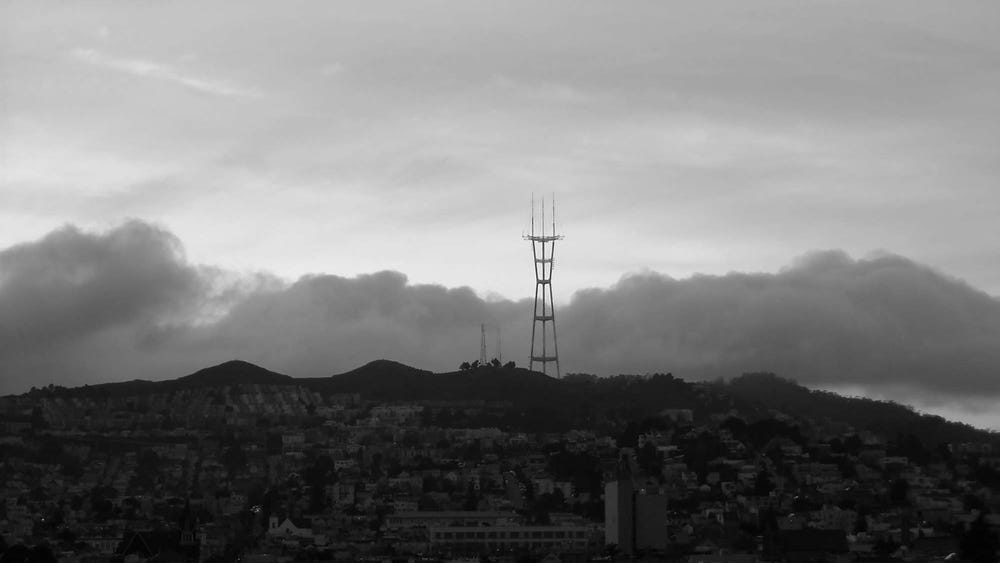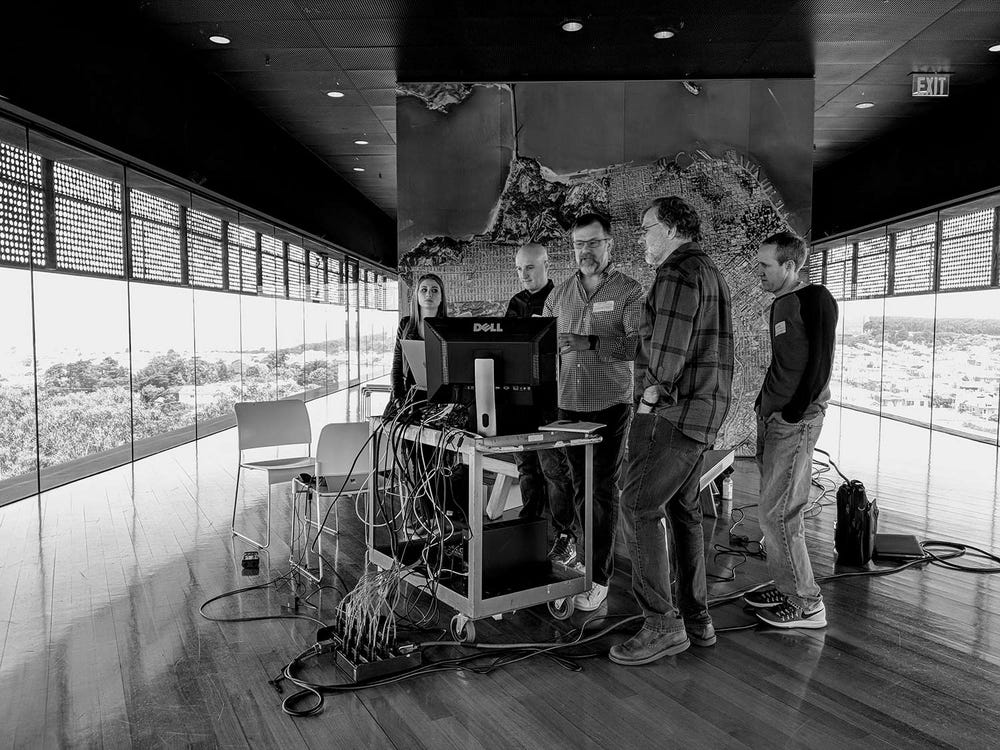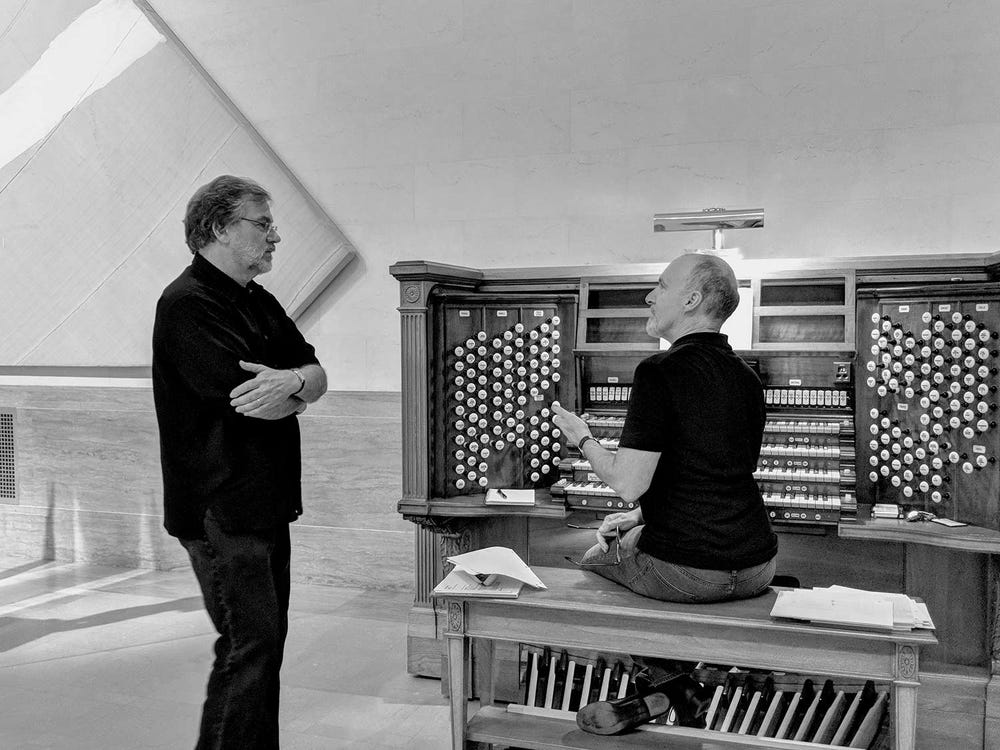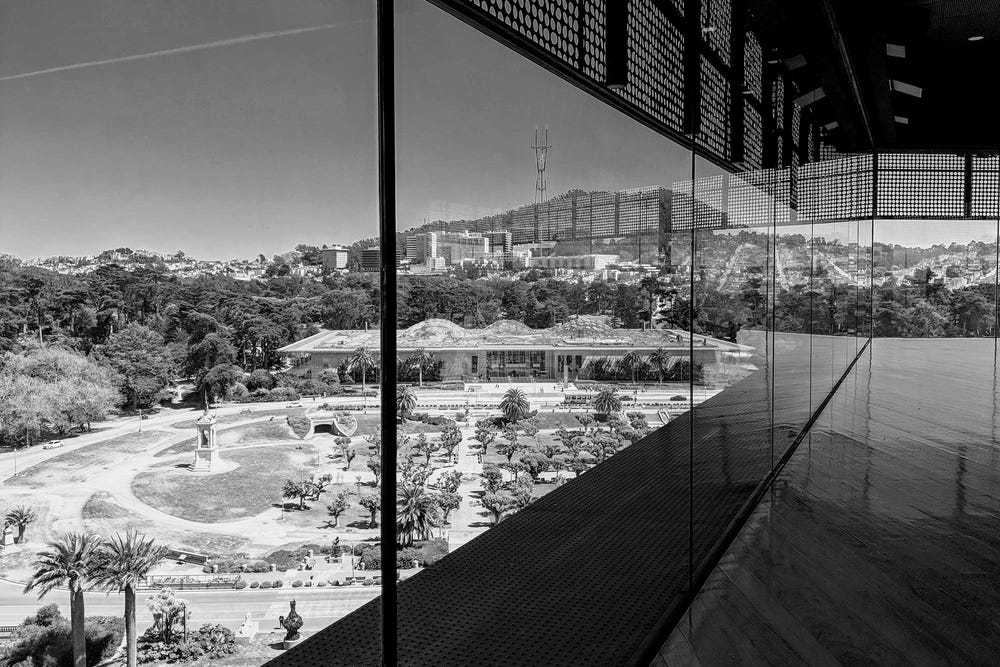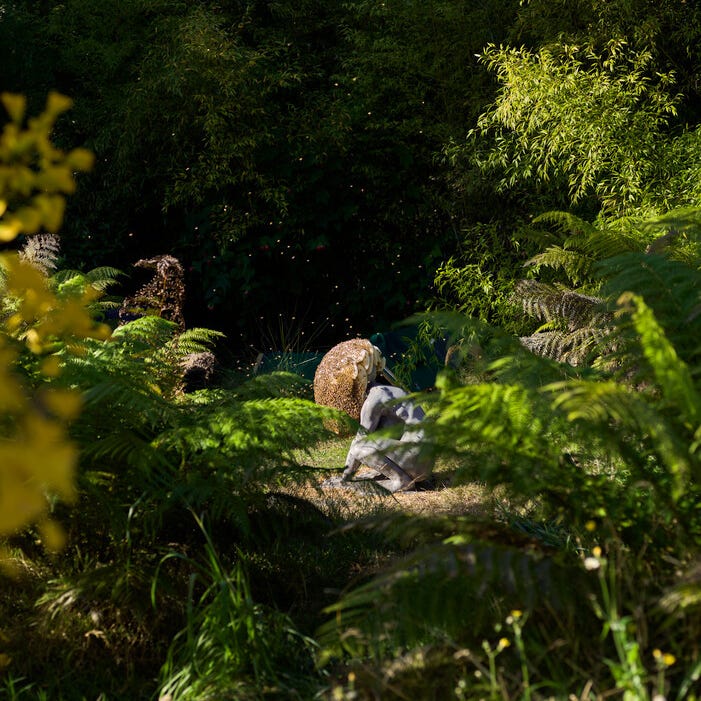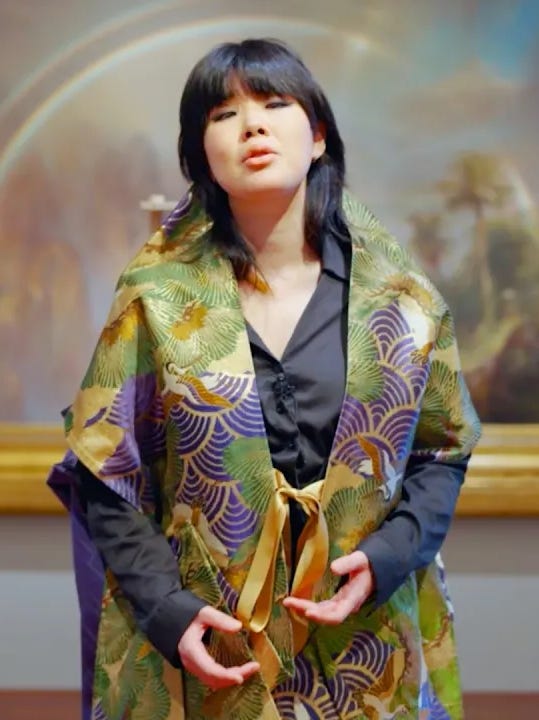The first commissioned artist project for the de Young’s iconic Hamon Tower Observatory, The Companions: Sounds for a Lost Screenplay, is a cinematic audio environment created by artist Anthony Discenza in collaboration with Sound Designers Gary Rydstrom and Josh Gold of Skywalker Sound. Inspired by Discenza’s research into the history of The Companions, a genre-defying screenplay from the 1980s that had never been produced, the work explores the vital role sound plays in shaping narrative and affective space in film. Using immersive and directional sounds, the installation moves visitors through different thematic, narrative, and atmospheric components of The Companions, using the sweeping views from the Tower as a framing device.
A Film without Images
Following his initial discussions with Director of Public Engagement, Elizabeth Thomas, about a project for the Hamon Tower site, Discenza had conceived the idea for an “auditory cinema,” consisting only of sound elements, which could be superimposed over the observatory’s expansive, 360-degree views. He envisioned working with professional sound designers from the film industry to create a composition that would evoke a cinematic experience purely through audio. “I had been thinking about all the different aspects of production that go into film,” Discenza recalls, “and how some don’t receive the same kind of visibility or attention as direction or acting. In particular, I was interested in the role of sound design, and so I wanted to see what might happen when the visuals are taken away and the work of the sound team takes center stage.”
Discenza had been inspired in part by Michel Chion’s analysis of sound in film, Audio-Vision: Sound on Screen, in which he argues that sound shapes visual perception in film to a much greater extent than we realize. In cinema, sound design lends weight and dimension to the images onscreen, providing a film with much of its sense of reality and continuity (regardless of how naturalistic or fantastical the world depicted may be) in a way that seems so natural and inevitable that our awareness of its constructed nature disappears. Chion terms this effect, which sits at the center of all relations between sound and image in cinema, the "audiovisual illusion." He further articulates this concept through something he calls added value.
—Michel ChionBy added value I mean the expressive and informative value with which a sound enriches a given image so as to create the definite impression, in the immediate or remembered experience one has of it, that this information or expression "naturally" comes from what is seen, and is already contained in the image itself. Added value is what gives the (eminently incorrect) impression that sound is unnecessary, that sound merely duplicates a meaning which in reality it brings about, either all on its own or by discrepancies between it and the image.
Intrigued by Chion’s argument, Discenza wanted to see if it might be possible to create a “sound film,” a work constructed solely from sound elements but which still strongly conveyed the vernacular of cinema. “I saw the project very much as an experiment,” he says. “Frankly, I had no idea if it would be interesting to sound professionals. But when I talked to the team at Skywalker Sound, they were all immediately on board.”
Skywalker had always been Discenza’s first choice for the project, in large part because of the company’s iconic status in the motion picture industry. “Lucasfilm, Skywalker, ILM—these names are all synonymous with big, spectacle-driven moviemaking,” he notes. “They’ve worked on more films than you can count; for almost four decades now, they’ve engineered the sights and sounds that populate our collective cinematic imagination. I thought it would be amazing to have sound designers from Skywalker work on this—and because they’ve always been associated with the Bay Area as much as with Hollywood, I was hoping the local angle of the project might also appeal to them.”
As an artist who often works with withheld or imagined narratives, Discenza proposed that Rydstrom and Gold create their own interpretation of an unrealized film using only sound design elements. In pitching his concept, Discenza framed it as an inversion of the normal relationship between sound designer and filmmaker: “In my first meeting with Gary, I told him, ‘think of me as a director hiring you to do the sound design for a film—except in this case, the film doesn’t actually exist.’ So it’s really the sound designer creating the whole movie.” From Rydstrom’s perspective, Discenza’s proposal was irresistible: “After working on so many films, the notion of developing a sonic environment for an unmade film was really appealing to me, in that it gave me an opportunity to illuminate the enormous role sound plays in film—without having to be tied to any images.”
The Skywalker Sound team setting up in Hamon Tower.
A Lost Screenplay
Realizing that they would still need some sort of narrative framework for the project, the team decided to build the composition around a screenplay from Hollywood’s vast repository of unrealized scripts. “We wanted to find a story that hadn’t made it off the page, one of those projects that became hopelessly entangled in the complex machinery of the motion picture industry,” Discenza recalls:
"In one of our earliest conversations, Gary and I discussed the recent documentary about Alejandro Jodorowsky’s failed attempt to adapt the novel Dune. What was particularly interesting to us was how, even though Jodorowsky’s project was never realized, various elements of the production design material—sketches, storyboards, music—that he and his team had generated got circulated around Hollywood, and somehow found their way into dozens of other films over the years. Something similar happened with Claire Noto’s infamous screenplay, The Tourist, another great science fiction story that also got stuck in development hell and wound up having parts of its story cannibalized by other films. So there was this idea of the unmade film existing as a ghost inside other movies that did make it to the screen; this became a stepping-off point for us…we thought it would be a great challenge to take one of these lost projects and see if we could bring a version of it to life using the tools of the sound designer."
In researching possible screenplays to work with, Discenza stumbled across a reference to a screenplay called The Companions, which had been written in the early 1980s by a woman named Carol Montana. Montana’s script had a turbulent history; it had been optioned numerous times but never managed to make it into production for one reason or another. The more he learned about the screenplay and its troubled past, the more intrigued he became. “The Companions immediately felt like a great fit to me—the story itself had so many weird elements; it had all these features we associate with the blockbuster, but other aspects of the script made it sound more like an art film. The fact that it was set in San Francisco and made heavy use of locations throughout the city was also a major draw, in that it offered us an opportunity not only to use the incredible views from the Hamon Observatory as a kind of container for the audio, but to tie into the whole history of films set in the city. It gave the whole project a kind of site specificity that seemed really exciting.”
Given the breadth of Skywalker’s sound design work, the team wanted the project to reference a wide range of movie genres, so the multifaceted nature of Montana’s story was appealing as well. The Companions combines aspects of at least a half-dozen different genres, from hard-boiled noir to erotic psychological thriller. For Rydstrom and Gold, this suggested a vast playground of sonic possibilities to explore. As designers with decades of experience working on big-budget, effects-driven movies (most recently, Rydstrom was the Supervising Sound Designer for Steven Spielberg’s Ready Player One, while Gold just finished working on Avengers: Infinity War), they hoped to use the project to talk about the enormous vocabulary of cinematic sound and the myriad ways it can be used to shape a story.
Although a complete version of Montana’s screenplay no longer exists, Discenza saw this as an opportunity rather than a limitation. “We never wanted to work off a script too directly,” he notes. “In the case of The Companions, we really couldn’t, because there appears to be no intact copy of it available anywhere—all we have are a few sections of it, and a lot of anecdotal accounts drawn from interviews and various articles written over the years. But I also saw the sound work as being more about interpretation and imagination, on the part of Gary and Josh as much as the audience. So while we wanted the project to pay homage to The Companions, we thought of the script more as a kind of prompt, a basic armature off of which they could construct the sound composition.”
Through his research, Discenza was able to assemble a wealth of information about Montana’s screenplay, enabling him to reverse-engineer elements of the story’s narrative structure; he then turned these materials over to Rydstrom and Gold to realize as they saw fit. The goal was to create an affective environment that was based on the unrealized script, but which still left much of the story itself to the viewer’s imagination. “The core part of the sound designer’s job is creating mood,” says Rydstrom. “A huge component of what you experience emotionally in a film is really set by the sound, though often it’s in ways you may not be fully conscious of. So what seemed like such an interesting challenge with this was to see how you could use sound alone to suggest all of a film’s complex narrative structures and shifts, without telling too specific a story.”
Gary Rydstrom working with organist Jonathan Dimmock during the recording session at the Legion of Honor.
Constructing a Sound Film
In designing the sound composition, Rydstrom and Gold approached the project in many ways as they would a film, using the film industry’s standard three-act structure as their template. “Basically, I built scenes and shots as though it was a normal production,” Gold says. “I typically start out with way too much stuff—my initial edit of the first act alone was 20 minutes—which is what often happens in a film production. It’s not unusual that a first cut will be 5 hours long. So a big part of the process is actually going through and getting rid of a lot of things that you’ve put in, continually cutting and trimming. So in some ways it’s been very similar to working on any movie.”
Although there was a certain freedom in not having to tether the sound to any action or dialogue, this was also part of the challenge for the two designers. Instead of a rough cut, which sound designers typically use to compose, all they had to work with were the notes Discenza had compiled about Montana’s screenplay. These consisted primarily of descriptions of a handful of specific scenes, references in the script to other films and books written or set in San Francisco, and Discenza’s own comments regarding the sort of mood or atmosphere he imagined for the story. Occasionally, this left Rydstrom and Gold in uncharted territory. “On a normal production, the image can be a crutch,” says Gold. “Typically, whenever I get stuck, I always look at the screen, because that’s where the answers usually are…but here I wasn’t able to do that, so I had to invent other ways to navigate through the process. Sometimes I would just put up an image of the view from the tower and work off that.”
Ultimately, Rydstrom and Gold had to be guided by the images or associations the material conjured in their own imaginations. Part of their strategy was to incorporate sounds that they had always wanted to use but for which the right project had never come along, or sounds they had built for other films that hadn’t made it to the final cut. “In any project, there’s always elements you get really attached to that for one reason or another don’t make it in,” says Gold. “This project became a way for some of that material to have a second life…there are a few ghosts from other movies lurking in this one.”
Another component of Rydstrom and Gold’s approach was to connect aspects of the composition to some of the San Francisco locations depicted in the screenplay. Since one of the things that had drawn the team to The Companions in the first place was the way its narrative was so steeped in the city’s unique landscape, this seemed to be another way to give the work a layer of site specificity. Montana’s screenplay is filled with scenes that take place at well known landmarks, such as The Legion of Honor and the old Pacific Bell building at 140 New Montgomery. In particular, the enormous and iconic Sutro Tower (which sits directly opposite the Hamon Observatory) plays a starring role in The Companions, a sinister focal point around which the story orbits, and where it reaches its violent, transcendent culmination.
Rydstrom and Gold used these references as entry points into the sound piece. Most notably, The Companions’ opening scene at the Legion of Honor gave the designers an opportunity to access the enormous Skinner Organ, a 4,500-pipe instrument that had been built into the very architecture of the museum during its construction. The team spent several afternoons recording organist Jonathan Dimmock running through various compositions, including works by Mendelssohn and Oliver Messiaen, that eventually became central components of the project’s “score.”
The work makes extensive use of Skywalker’s vast catalog of sound elements, along with the field recordings made at the Legion of Honor. Rydstrom and Gold used over 1,500 discreet sound elements in the composition, with around 200 of those being new sounds created specifically for the project (many of these include the communication and transmission effects, along with a set of sounds Gold describes as “time/space/reality bending” elements.) Reflecting The Companions' San Francisco setting and the placement of the work in Hamon Tower, the composition also features many iconic sounds associated with the city, such as streetcars, foghorns, and seagulls. Meanwhile, in keeping with the tradition of the Marvel Comics movies on which Gold worked, the composition contains a number of hidden "Easter eggs" and other filmic references, especially to other movies set in the city (the bongos from The Conversation make an appearance).
This aspect of the work subtly highlights another practice of sound design that often goes unnoticed by general movie-going audiences: the recycling of sounds for use in different films. The most well known example is the infamous “Wilhelm scream,” which has been used in over 382 films since it was originally recorded in 1951. These hidden sonic linkages between unrelated films is reflected in Sounds for a Lost Screenplay; for example Rydstrom uses wind elements that were originally created for Pixar’s A Bug’s Life—but which would be perhaps more likely recognized by a listener as the sound of the wind from the iconic “King of the world!” scene in James Cameron’s Titanic.
The final 24-channel composition is a moody, urgent fusion of multiple cinematic genres explored through the vernacular of sound design. Using Discenza’s notes as their departure point, Rydstrom and Gold eventually constructed their own vision of The Companions, building a sequence of scenes that takes the audience from an unnerving encounter in Golden Gate Park, through the labyrinthine interior of the malign corporation Global Sequence, to a cataclysmic confrontation atop Sutro Tower. Distilling an entire movie’s worth of story into a compact 20 minutes, the composition hurtles listeners from the naturalistic sounds of crowded city streets into highly constructed effects suggestive of malignant extra-dimensional forces and fractured time. The sound composition does not “tell” the story of Montana’s screenplay so much as it channels it, immersing listeners in a sonic environment that continually articulates different tropes of cinematic narrative. Rydstrom and Gold make generous use of sounds one might imagine in the context of a “conventional” action film—motorcycles chases, circling helicopters, but usher in a wealth of stranger, less identifiable sounds less tethered to clear action. Rydstrom, who worked on the sound for films like Minority Report and AI, describes his and Gold’s interpretation of The Companions as “psychological science fiction,” but also sees the project as a consideration of his role in the film industry. “The work is definitely self-aware,” observes Rydstrom. “In some ways the project is Josh and I thinking about our relationship to movie-making as much as it’s our interpretation of the screenplay.”
When you're done reading, continue learning about the project in Part II: The Story.
